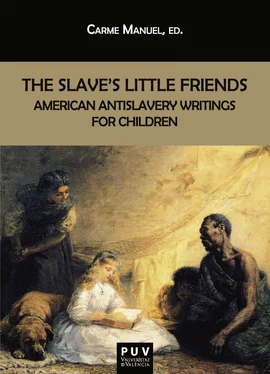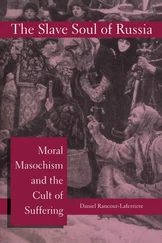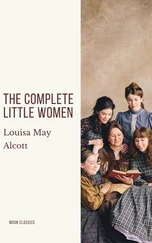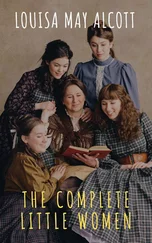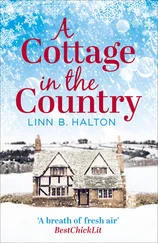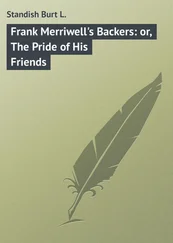In 1806 Wakefield published Excursions in North America: Described in Letters from a Gentleman and his Young Companion, to their Friends in England , “one of the first children’s books to deal with the issue of American slavery” (Oldfield 145). In this text she talked about the visit of two English travelers to the recently founded American republic who, after purchasing a black slave, Sancho, at an auction in Charleston, North Carolina, free him and engage him as their guide through other states. In a letter to his brother, one of the travelers, Henry Franklin, writes about the feelings that black slaves awaken in his friend Arthur, his travelling companion:
After one of these handsome entertainments, where we had been attended by negro slaves, I observed a cloud upon the brow of my young friend, for which I could not account, till he confessed, that the sight of men, who were the property of their fellow creatures, and subject to every indignity, excited such painful reflections, that he could not banish them from his mind. I endeavoured to soothe him, by representing that their treatment here is gentle, compared with that exercised in the southern states, and in the West Indies; though the efforts that have been made for the abolition of slavery, have improved their condition every where. It is indeed to be regretted, that men, so ardent in the love of liberty for themselves as the Americans are, should continue, in any degree, to tolerate the slave trade (19).
In 1807 the English Parliament prohibited British participation in the African Slave Trade and, a year later, the United States also outlawed American participation in the trade. This new scenario shifted the attention from the injustices of the slave trade towards chattel slavery as it was known in the West Indies and the South of the United States. As Philip Gould explains, “the savage slave trader continued to function iconically in the abolitionist imagination. The figure still had rhetorical and emotional effect. This marks an important site of rhetorical continuity between eighteenth- and nineteenth-century antislavery writing. […] As southern apologists criticized the severity of the northern industrial economy, northern abolitionists (many of them urban and industrial reformers as well) responded in kind by employing the well-established trope of the slave trade. It helped to secure regional claims to ‘civilization’” (Gould 192).
After the abolition of the slave trade, authors concentrated on criticizing the institution. As shown by the number of women authors penning antislavery stories, British women, as would happen with their American sisters, played a fundamental role in the antislavery campaigns from the middle of the eighteenth-century throughout the nineteenth century. Even if politically disenfranchised, they involved themselves in all venues of social and political reforms, and some of them (Elizabeth Heryrick Anne Knight, Elizabeth Pease) remained active until the abolition of slavery in the West Indies in the 1830s.
In 1821, Mary Martha Sherwood published Dazee, or the Re-Captured Negro , which had at least three American editions (1821, 1822 and 1834). It tells the story of Dazee, an African boy, who is captured by a slave trader, released by the English government, and then sent to the colony of Sierra Leone, where he is reunited with his elderly mother. As Martha Cutter explains, the text “relies on existing iconography to make its argument. Dazee is a literal replication of the Wedgwood supplicant slave, repurposed and repackaged but with unchanged features. The enslaved African in Sherwood’s text is the recipient of the gaze of both the individual in the image (on the left of the frontispiece) and of a reader. The enslaved African does not return the gaze of a reader, nor does his imprimatur contest the dominant scopic order of slavery in any way” (81-82).

By contrast, Amelia Opie’s The Black Man’s Lament; or How to Make Sugar (Harvey & Darton, 1826), according to Cutter, depicts “distinctive (rather than stereotypical) persons, unbroken corporealities that can assert a mode of ocular resistance. Again and again her illustrations depict men and (sometimes) women who appear to be staring away from the action of the scene and back at the viewer” (82).
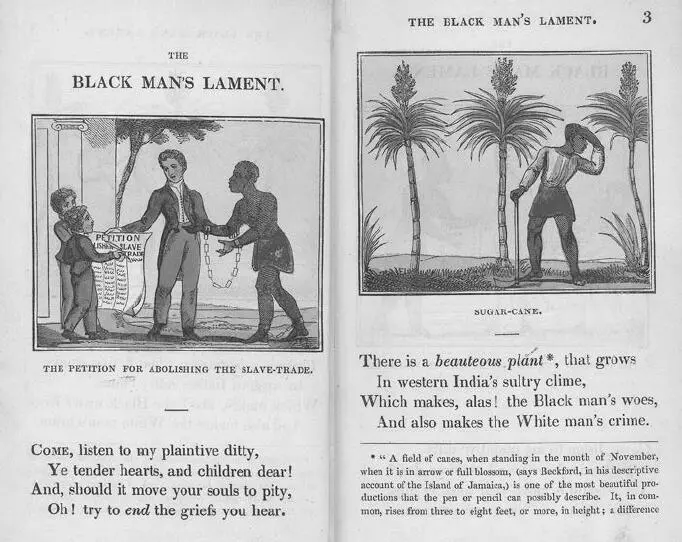
The Black Man’s Lament , published as part of a collection of essays for children, tells the life of a slave captured by slave traders in Africa and condemned to work on a West Indian sugar plantation. The book contained fifteen hand-colored copperplate engravings that help visualize a new conception of children as citizens with moral responsibility to act politically. The style of the images shows that Harvey and Danton most probably engaged the same artist who had illustrated Cowper’s reprint of his celebrated The Negro Complaint for children, as mentioned above. As Cutter explains, the illustrator projects his respectful attitude towards blacks because these characters are represented as persons who “mobilize a politics of empathy and intersubjectivity that attempts to move beyond spectatorial sympathy by pushing a viewer to see the enslaved as connected with his or her own subjectivity, on terms of parity and equality” (xii). Thus, the first page opens with a plea for children to sign a petition to abolish the slave trade and the second attacks the cultivation of sugar cane and the transatlantic commerce of sugar as one of the roots of the evil of slavery:
Karen Sands-O’Connor (35) points out that, throughout her abolitionist poetry, Opie underlines the fact that slavery is a sin “not through ambivalent or guilt wracked white characters, but through adopting the slave’s own voice, thus forcing the recognition of the humanity of the slave” (35). The speaking voice in The Black Man’s Lament addresses children directly and emboldens them to take action against the dehumanizing system. The use of the first-person voice is, according to Sands-O’Connor, unique in children’s abolitionist literature, despite the story’s frame, and it is how Opie achieves what other children’s authors failed to do: turning the slave from object or animal into a human (35). Martha Cutter also underlines the prominence of Opie’s volume as one of the earliest and most elaborate graphic illustrated books for children exclusively devoted to an antislavery topic, since “it forwards the idea that the child’s example could motivate an adult reader […] envisioning of the child as a proto-political subject who inspires adult action may also have enabled the cultural work of a text such as Uncle Tom’s Cabin , which takes a similar approach to the function of children like Little Eva.” Thus, Opie “foreshadows how, in later years, the child became a unique catalyst and model for social change” (10-11).
Opie’s text, like others previously discussed, stands out amongst a vast array of British literature for children exhibiting tales of wild heathen savages in overseas territories. Yet Sands-O’Connor (21) clarifies a distinction between those books dealing with people in the Pacific islands and those about the inhabitants of Atlantic islands. “As the people providing manual labor for the farms of their British colonizers, the non-European Caribbean subjects—predominantly kidnapped West Africans—were a curious mix of wildness and domesticity,” she explains. Opie and her antislavery literary companions for children also offered this blending of peacefulness and violence, a dual description that “prepared their readers for the potential dangers, and perhaps the impossibility, of controlling the British Empire” (21). According to Cutter, “the black man’s rage in Opie’s text may denote that he can never fully embrace Christianity and might instead embrace bloody insurrection” (84). Hence, “her text portrays the opposite of the colonial discourse of enslaved, Christianized passivity, a ‘shadowy textual presence’ (Ferguson 5) that includes the potential rebellion of slaves against this colonial discourse” (85).
Читать дальше
